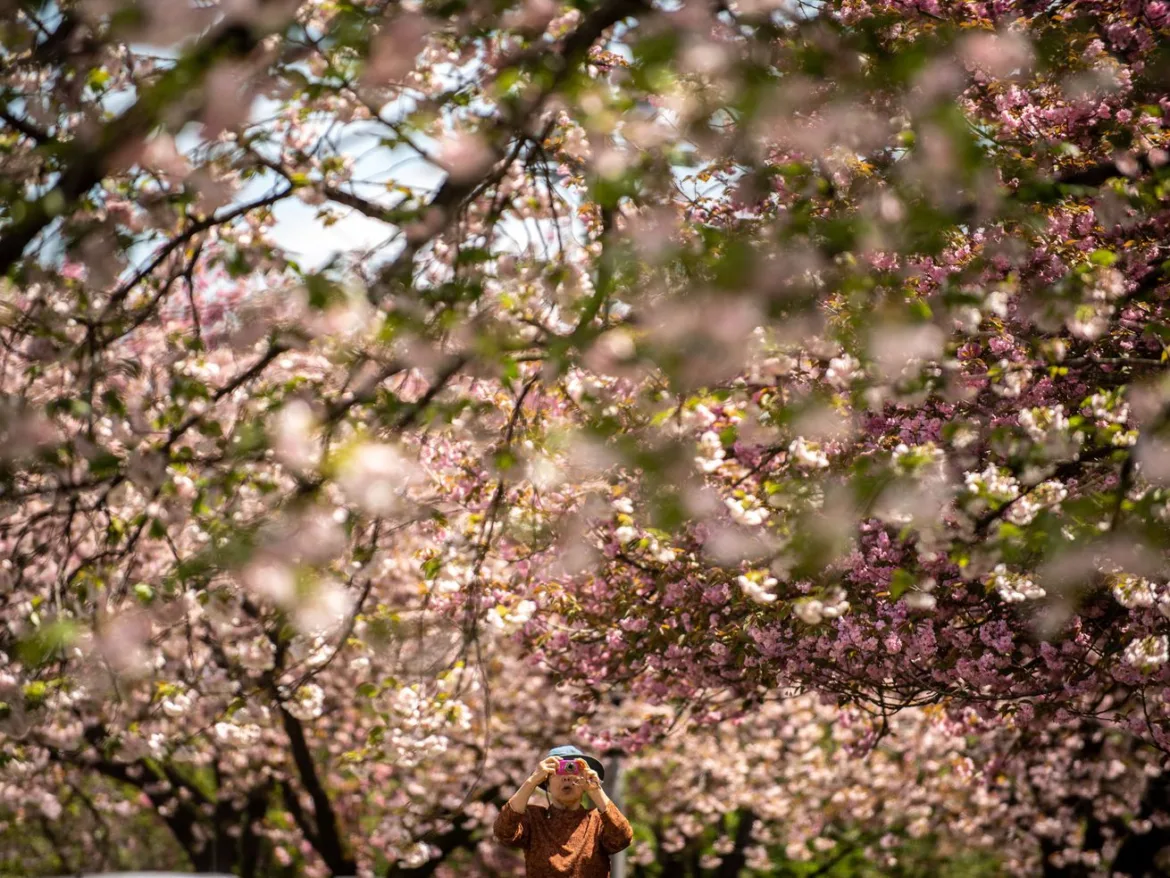The age-old Japanese tradition of hanami has become a harbinger of change.
For outsiders who can’t resist the urge to make sweeping generalizations that will later prove highly embarrassing, Japan provides particularly dangerous ground. As someone who spent parts of 2006 and 2007 as a foreign correspondent in Tokyo, I should know.
It’s a culture that seems to carry over practices virtually unchanged over millennia yet embraces the new relentlessly, an island nation that dwelled in enforced isolation for centuries yet eagerly adapted the foreign when available — from shock-doctrine Western industrialization after the Meiji Restoration in 1868 to the packs of leather-clad, 1950s-style rockers I would see gathering in Yoyogi Park on Sunday afternoons. Land of contrasts and all that. Tread carefully here, and know the many, many things you don’t know.
But there are certain aspects of Japan that are clear to anyone, even a young reporter on his first night in the country, dropped off the Narita Airport shuttle at the lobby of the Imperial Hotel in Tokyo. One of those things is the coming of the cherry blossoms. Every spring on Japan’s four main islands, from the southwestern reaches of Kyushu to the northern island of Hokkaido, the country pauses to witness the brief flowering of the sakura, the cherry blossoms. It’s a moment, a few days at most, when a country that otherwise feels as though it is in perpetual motion comes to a halt to engage in hanami — gathering to see the blossoms, well, blossom.
But thanks largely to climate change, that moment is more vulnerable than ever.
A brief blossom
You could say that the cherry blossom is the national symbol of Japan, and while you would be trespassing into cliché, you wouldn’t be wrong, exactly. Saga was the first Japanese emperor to organize a hanami gathering early in the 9th century AD, and The Tale of Genji, perhaps the world’s first novel, includes scenes of aristocrats celebrating hanami. In 1594, the great Shogun Hideyoshi Toyotomi held a five-day hanami party for 5,000 attendees in Yoshino, part of a tradition that has continued, spring after spring, to the current day.
Each year as the winter dwindles, Japanese people look to the sakura zensen, the cherry blossom report, to know when and where the trees will flower. Advance notice is critical — in a normal year, more than 60 million people will travel to and within Japan to view the bloom, pumping some $2.7 billion into the economy, according to an analysis from Kansai University. Much of that will be spent by Japanese companies hosting corporate hanami parties for employees. As the sakura season begins, you can see the most junior workers, tasked with securing a picnic spot for the office hanami, flocking to 1,000 cherry blossom viewing spots around the country so their superiors can eat and drink in full view of the trees.
And why do they come? Perhaps, like the 17th-century haiku master Matsuo Basho, they wish to engage in mono no aware, the art of appreciating impermanence, symbolized by the flowers that bloom each year in a momentary brilliance of white and pink before falling to the earth. “How many, many things / They call to mind / These cherry blossoms! / Very brief —”
Or perhaps, as I did in my one very brief Tokyo spring, they come for the party. During that one week in spring, in the capital’s comparatively few parks — per person, Tokyoites enjoy perhaps a quarter of the greenery of a resident of New York or London — the sakura show off with a riot of color that offsets the concrete and the neon. There’s no better place to be than beneath those airy boughs on an April evening, drinking sake and beer with colleagues and friends.
Yet one does not need to have the soul of Basho to know that there is something special about the blossoming. Yes, the blossoms are beautiful not just in themselves but in their brevity, a fact they remind us of when they inevitably fall to the ground after the bottles and the bento boxes have been cleared. “If the cherry blossom can still be relied upon to bloom at a specific time, it can also be relied upon to die soon after,” the novelist Hanya Yanagihara wrote in 2019. “For 51 weeks, one waits, and within seven days at most, one is consigned to waiting once more.”
The turning of the seasons provides rhythm and meaning in Japan, with its “rigorous and distinct sense of aesthetics, one that has been founded on a celebration of seasonality.” So many of my memories of my time in Japan are tied to the seasons: the turning of the autumn leaves as I walked the temples of Kyoto with my mother; the snowflakes coating the grounds of the Imperial Palace one winter evening; the paper lanterns of the Obon festival glowing along a Tokyo alleyway on a hot summer night. And yes, hanami in the spring, always in the spring.
It’s not the seven days of bloom that give hanami its significance, but the 51 weeks of waiting on either side — waiting, but knowing the time will return, as it always has. The blossoming may be brief, but the oldest of the trees can live for centuries or even longer. Through earthquakes, tsunamis, revolutions, and war, the trees have their turn, as reliable as the spinning of the Earth.
How climate change alters the hanami
Which is why what has happened to the cherry blossom season in Japan and elsewhere in recent years is so disquieting.
It comes down to climate change. Cherry trees require a month of winter temperatures below 41 degrees Fahrenheit to fully bloom. As the climate has warmed in Japan, the timing of the blossoming has altered. As Bloomberg reported, between 1961 and 1990, cherry trees starting blooming in Tokyo around March 29. Between 1991 and 2020, the average bloom date moved to March 24.
Over in Washington, DC — which has its own cherry trees thanks to a gift from the Japanese government more than a century ago — the cherry blossoms have already arrived, in the second-earliest peak bloom in more than a century of data. And with temperatures continually warming, we can expect those records to fall: One study of Washington’s trees estimated that with moderate warming, peak bloom could be five days earlier by the 2050s and 10 days earlier by the 2080s.
All is change in the world, as the Buddha said, and to experience hanami is to appreciate that beauty is inseparable from impermanence. But what comforts the ache of witnessing the blossoms is the promise that they will return again and again. Should that be lost, then all we will have left is loss.
Update, March 19, 2024, 12:00 pm: This story was originally published on May 19, 2022, and has been updated to reflect news about earlier cherry blossoming in Japan and Washington, DC.



